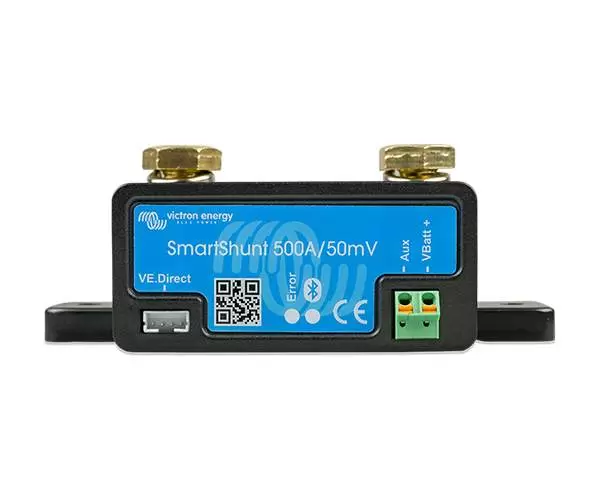In the pursuit of enhanced energy efficiency and meticulous energy management, the Victron Shunt emerges as a vital component. It is meticulously crafted to seamlessly integrate with a variety of energy systems, offering detailed insights into power consumption and battery health.
Whether you are managing a residential solar installation or overseeing a complex commercial energy system, the Victron Shunt is engineered to provide precise and real-time data. By monitoring current flow and converting it into a digital signal, this device facilitates informed decision-making about your energy usage. This enables users to optimize energy consumption, enhance system efficiency, and maintain battery health more effectively.
Versatility of the Victron Shunt
The versatility of the Victron Shunt means it can be utilized in a broad range of applications. From smaller setups requiring moderate monitoring to high-capacity systems demanding accurate and comprehensive data, there is a model suited to every need. This flexibility makes it an indispensable tool in the toolkit of anyone serious about energy management.
The data provided by a Victron Shunt is invaluable in identifying inefficiencies within your energy system. With precise measurements of current flow and power usage, it is possible to pinpoint areas where energy is being wasted and take corrective action. Additionally, by keeping track of battery status, users can ensure optimal performance and longevity, thus safeguarding their investment.
As the energy landscape continues to evolve, the importance of accurate and reliable energy monitoring cannot be overstated. The Victron Shunt is at the forefront of this evolution, providing the tools necessary to navigate the complexities of modern energy systems with confidence and efficiency.
Understanding How a Victron Shunt Works
A Victron Shunt operates on basic principles of electrical measurement, serving as a precision device that monitors current flow within your energy system. At its core, it comprises a high-precision resistor connected in series with the load. As current passes through the shunt, a small voltage drop occurs across the resistor, proportional to the current flow. This voltage drop is then measured and converted into a digital signal, offering real-time data on energy consumption. The key components involved include the shunt resistor, an internal processor, and interfaces for connecting to monitoring systems.
When current flows through the circuit, it creates a voltage difference across the shunt resistor. This difference is directly related to the amount of current passing through, allowing the shunt to provide accurate readings. The internal processor within the Victron Shunt then interprets these readings and translates them into a digital format. This data can be viewed on connected monitoring equipment, providing valuable insights into the system’s performance.
Another important aspect is the connectivity features of the Victron Shunt. Modern models often include Bluetooth capabilities, enabling wireless communication with monitoring devices. This feature simplifies the process of accessing and analysing data, making it easier to identify patterns and potential issues. Additionally, Victron Shunts are designed to integrate seamlessly with various energy management systems, ensuring compatibility and ease of use.
By continuously monitoring the current flow, the Victron Shunt helps users to maintain optimal energy efficiency. It allows for the identification of inefficiencies and the implementation of corrective measures. This continuous feedback loop is crucial for maintaining the health and longevity of the entire energy system.
Selecting the Right Smart Shunt for Your Needs
Choosing the right Victron Smart Shunt for your energy monitoring system involves several considerations. Start by evaluating your system’s maximum current rating, as the shunt must handle the peak currents without overheating or losing accuracy. Victron offers models such as the Smart Shunts 500A, ideal for high-capacity systems, and smaller models suited for less demanding applications.
Consider your system voltage as well. Victron shunts are designed to operate within specific voltage ranges, and selecting a model that matches your system voltage ensures compatibility and optimal performance. Additionally, assess the specific requirements of your application. For example, if you need detailed monitoring for a large solar installation, a high-capacity shunt with comprehensive data output would be beneficial.
Take into account any additional features that may enhance your monitoring setup. Modern Victron shunts often come with Bluetooth capabilities, allowing for wireless connectivity and easier data access. This can be particularly useful for remote monitoring and real-time analysis. Ensure the shunt you choose integrates seamlessly with your existing energy management systems.
Lastly, consider future scalability. If your energy system is likely to expand, opt for a shunt that can accommodate higher capacities or offers modular add-ons. This foresight can save time and money in the long run, ensuring your monitoring system grows with your needs.
By carefully assessing these factors, you can select a Victron Smart Shunt that meets your specific requirements and enhances the efficiency of your energy monitoring system.
Step-by-Step Installation Guide
To install a Victron Shunt, gather basic tools such as a screwdriver, spanner, and appropriate cables for connection. Begin by disconnecting the power supply to ensure safety. Identify a suitable mounting location near the battery or power source, ensuring it is secure and accessible. Attach the shunt’s high-current terminals in series with the load, ensuring all connections are tight and secure to prevent electrical issues. Once mounted, connect the monitoring cables to the shunt’s output terminals, and then to your display or monitoring equipment.
After securing all connections, double-check for any loose wires or potential hazards. Reconnect the power supply and power up the system. Follow any additional configuration steps outlined in the user manual to ensure the shunt communicates correctly with your monitoring devices. If your model includes Bluetooth capabilities, use the relevant app or software to establish a connection and verify that data transmission is functioning as expected.
During the installation, refer to the manufacturer’s guidelines for specific voltage ranges and current ratings to avoid potential damage to the shunt or your energy system. Familiarise yourself with the troubleshooting section in the manual to address any issues promptly. Regularly update any associated software to maintain optimal performance and benefit from the latest features. Once installed and configured, monitor the system for any irregularities and ensure it operates within the specified parameters.
Configuring the Smartshunt with Monitoring Equipment
To configure your Smartshunt with monitoring equipment, begin by establishing a connection to your chosen display or monitoring system. Ensure the system is powered and operational before attempting the setup. If your Smartshunt model supports Bluetooth, utilise the associated app or software to facilitate a wireless connection. This often involves enabling Bluetooth on both devices and following pairing instructions.
Once connected, access the configuration settings via the app or monitoring interface. Adjust the parameters to suit your specific energy system requirements. This includes setting the correct current range, voltage thresholds, and any other pertinent values. Refer to the user manual for detailed guidance on recommended settings for your particular setup.
Calibration is a critical step in the configuration process. Ensure that the Smartshunt is accurately measuring the current flow and providing reliable data. Perform a calibration check by comparing the readings from the Smartshunt with a known, trusted measuring device. Make necessary adjustments if discrepancies are found.
For systems requiring advanced monitoring capabilities, explore any additional features offered by the app or software. This could include setting up alerts for unusual activity, generating reports, or integrating with other smart devices within your energy management network. Regularly update the app or software to benefit from improvements and new functionalities.
Maintain a close eye on the initial data to verify the accuracy of the configuration. Make any necessary adjustments to optimise performance.
Maintaining the Shunt Victron
Regular maintenance is key to ensuring your Shunt Victron remains reliable and effective. Begin by inspecting all connections for tightness and any signs of corrosion. Loose or oxidised connections can lead to inaccurate readings and potential system faults. Use a dry cloth to clean the shunt and surrounding components, keeping them free from dust and debris that could affect performance.
Periodically check the shunt for any signs of wear or damage. If you notice erratic readings or connectivity issues, consult the user manual for troubleshooting steps and solutions. Software updates are essential for maintaining optimal performance, so ensure you regularly update any associated apps or monitoring systems.
Keep an eye on the shunt’s calibration and re-calibrate if necessary, especially if you observe discrepancies in the data. Routine maintenance checks and prompt attention to any irregularities will help extend the lifespan of your Victron Shunt and maintain the efficiency of your energy system.
Benefits of Using a Victron Smart Shunt 500a
The Victron Smart Shunt 500a stands out for its capacity to enhance energy efficiency and accuracy in monitoring energy systems. With its ability to provide precise, real-time data on current flow and power consumption, it enables users to optimize energy usage and identify inefficiencies. This can lead to significant energy cost savings over time.
A notable benefit of the Smarts Shunt 500A is its contribution to battery health management. By offering detailed insights into battery status, it aids in extending battery life and improving overall system performance. This is particularly valuable for high-capacity energy systems where battery longevity is crucial.
The device’s Bluetooth capabilities further enhance its utility, allowing for seamless wireless connectivity and real-time data access via associated apps or software. This feature simplifies the process of monitoring and analysing energy data, making it easier to spot trends and potential issues promptly.
The Smarts Shunt 500A is also designed to integrate effortlessly with a variety of energy management systems, ensuring compatibility and ease of use. This flexibility makes it suitable for a wide range of applications, from residential solar setups to more complex commercial energy systems.
Additionally, the Smart Shunts 500A supports scalability, accommodating future system expansions without requiring significant modifications. This foresight ensures that your energy monitoring setup can grow alongside your needs, providing long-term value and adaptability.
Conclusion
The Victron Shunt proves itself to be a cornerstone in the realm of energy monitoring and management. By offering real-time data on current flow and power consumption, it empowers users to fine-tune their energy systems for enhanced efficiency. Selecting the right model tailored to your specific needs is vital, and understanding the installation process ensures that the device functions optimally from the outset. By integrating the Victron Shunt into your energy system, you can achieve significant energy savings, improved battery performance, and a more streamlined approach to energy management. Its precise measurements and robust features make it an invaluable tool for anyone committed to efficient and effective energy use.
FAQ’s
Q1: What is the main purpose of a Victron Shunt?
A: A Victron Shunt monitors current flow in an energy system, providing accurate data on power consumption and battery status, aiding in efficient energy management.
Q2: How do I choose the right model for my needs?
A: Assess your system’s maximum current rating, voltage, and specific application requirements. Victron offers various models to suit different capacities and features, including Bluetooth connectivity for ease of use.
Q3: Can I install a Victron Shunt myself?
A: Yes, with basic tools like a screwdriver and spanner, and by carefully following the installation guide, you can install a Victron Shunt. Always disconnect the power supply first to ensure safety.
Q4: What kind of maintenance does a Victron Shunt require?
A: Regularly inspect connections for tightness and signs of corrosion. Clean the shunt and surrounding components to keep them free from dust and debris. Ensure the device is calibrated correctly and update any associated software for optimal performance.
Q5: What benefits does the Victron Smart Shunt 500A offer?
A: The Smart Shunt 500A offers precise energy monitoring, Bluetooth capabilities for real-time data access, and detailed insights into battery health. It is ideal for both residential and commercial energy systems due to its high capacity and scalability.
| Related Business Listings |
| Contact Directory |
| Local Business Profiles |




